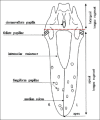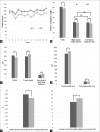Alterations in the gustatory papillae after anterior bite plate insertion in growing rats
- PMID: 31001496
- PMCID: PMC6416994
- DOI: 10.4103/jos.JOS_68_18
Alterations in the gustatory papillae after anterior bite plate insertion in growing rats
Abstract
Objectives: To determine whether the modification of dental occlusion, without molar extraction, affected the gustatory papillae located in the tongue of growing rats.
Materials and methods: Five-week-old male Wistar rats were randomly divided into an anterior bite plate (ABP) group and a control group. Under general anesthesia, ABPs were placed on the occlusal surfaces of the maxillary incisors, while metal caps covered the mandibular incisal edges of the rats in the ABP group. The control group rats underwent a sham operation. The rats in both groups were euthanized 14 days after the procedure. The circumvallate papillae and taste buds were analyzed by immunohistochemical methods, and the fungiform papillae were observed and counted after immersion of the tongue in 1% methylene blue.
Results: Two weeks after ABP insertion and mandibular incisal cap placement, the gustatory papillae exhibited morphological and structural changes. The rats in the ABP group had exhibited significantly fewer fungiform papillae, and narrower circumvallate papillae, with greater trench depths, larger trench profile areas, smaller taste bud profile areas, lower ratios of the taste bud profile area to the trench profile area, and more taste buds than those in the control group.
Conclusions: Our findings support the association between occlusal and taste functions and provide a basis for further studies on the gustatory function. In conclusion, loss of molar occlusion, resulting from the ABP and metal cap insertion, altered the peripheral gustatory receptors in the growing rats.
Keywords: Growing rat; gustatory papillae; occlusion; taste.
Conflict of interest statement
There are no conflicts of interest.
Figures





Similar articles
-
Degeneration of fungiform and circumvallate papillae following molar extraction in rats.Acta Odontol Scand. 2014 Nov;72(8):880-6. doi: 10.3109/00016357.2014.920105. Epub 2014 May 28. Acta Odontol Scand. 2014. PMID: 24866919
-
Unilateral nasal obstruction induces degeneration of fungiform and circumvallate papillae in rats.J Formos Med Assoc. 2018 Mar;117(3):220-226. doi: 10.1016/j.jfma.2017.04.013. Epub 2017 May 19. J Formos Med Assoc. 2018. PMID: 28532581
-
Quantitative study of taste buds in fungiform and circumvallate papillae of young and aged rats.J Anat. 1984 Mar;138 ( Pt 2)(Pt 2):323-32. J Anat. 1984. PMID: 6715253 Free PMC article.
-
Spacing patterns on tongue surface-gustatory papilla.Int J Dev Biol. 2004;48(2-3):157-61. doi: 10.1387/ijdb.15272380. Int J Dev Biol. 2004. PMID: 15272380 Review.
-
Scanning electron microscopical studies of developing gustatory papillae in humans.Chem Senses. 1997 Dec;22(6):601-12. doi: 10.1093/chemse/22.6.601. Chem Senses. 1997. PMID: 9455607 Review.
Cited by
-
Expression of Glucagon-Like Peptide-1 Receptors in the Submandibular Gland of Mice and Its Implications in Type 2 Diabetes.Cureus. 2024 Sep 29;16(9):e70465. doi: 10.7759/cureus.70465. eCollection 2024 Sep. Cureus. 2024. PMID: 39479116 Free PMC article.
References
LinkOut - more resources
Full Text Sources
Miscellaneous

